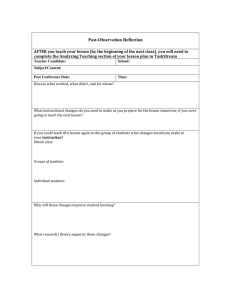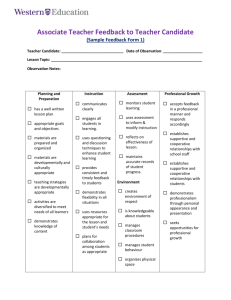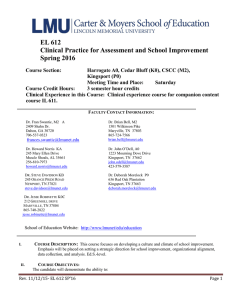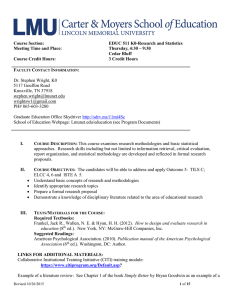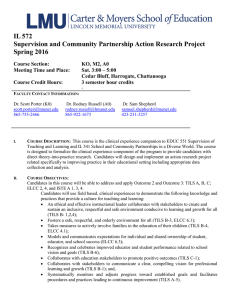IL 612 Clinical Practice for Assessment and School Improvement Spring 2016
advertisement
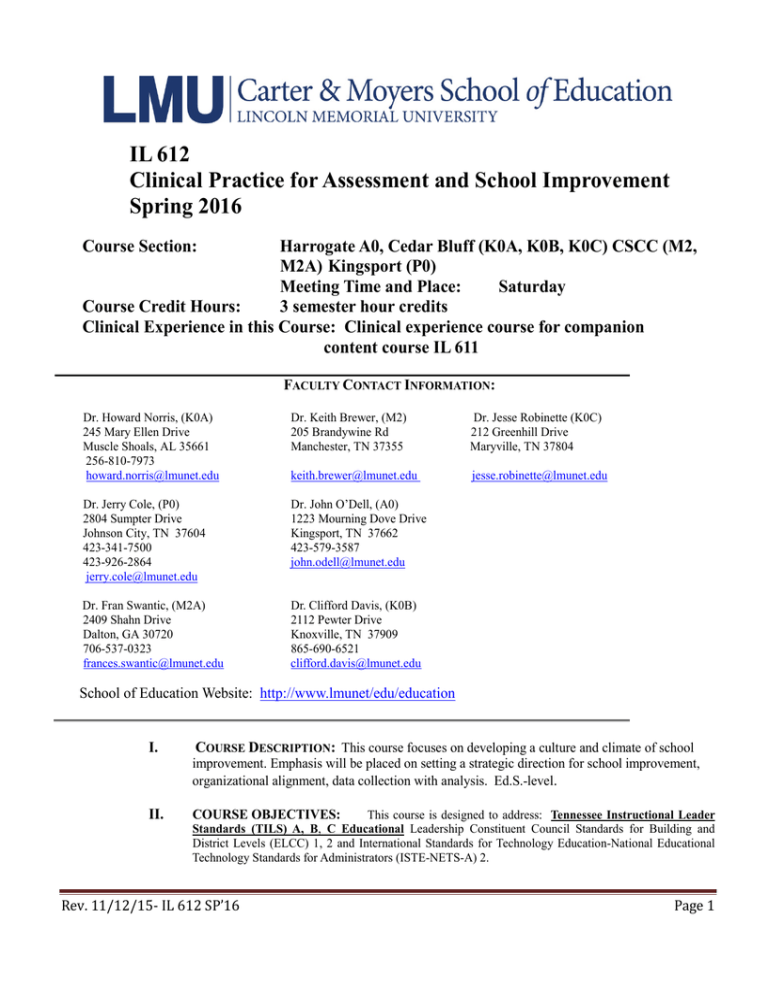
IL 612 Clinical Practice for Assessment and School Improvement Spring 2016 Course Section: Harrogate A0, Cedar Bluff (K0A, K0B, K0C) CSCC (M2, M2A) Kingsport (P0) Meeting Time and Place: Saturday Course Credit Hours: 3 semester hour credits Clinical Experience in this Course: Clinical experience course for companion content course IL 611 FACULTY CONTACT INFORMATION: Dr. Howard Norris, (K0A) 245 Mary Ellen Drive Muscle Shoals, AL 35661 256-810-7973 howard.norris@lmunet.edu Dr. Keith Brewer, (M2) 205 Brandywine Rd Manchester, TN 37355 Dr. Jesse Robinette (K0C) 212 Greenhill Drive Maryville, TN 37804 keith.brewer@lmunet.edu jesse.robinette@lmunet.edu Dr. Jerry Cole, (P0) 2804 Sumpter Drive Johnson City, TN 37604 423-341-7500 423-926-2864 jerry.cole@lmunet.edu Dr. John O’Dell, (A0) 1223 Mourning Dove Drive Kingsport, TN 37662 423-579-3587 john.odell@lmunet.edu Dr. Fran Swantic, (M2A) 2409 Shahn Drive Dalton, GA 30720 706-537-0323 frances.swantic@lmunet.edu Dr. Clifford Davis, (K0B) 2112 Pewter Drive Knoxville, TN 37909 865-690-6521 clifford.davis@lmunet.edu School of Education Website: http://www.lmunet/edu/education I. COURSE DESCRIPTION: This course focuses on developing a culture and climate of school improvement. Emphasis will be placed on setting a strategic direction for school improvement, organizational alignment, data collection with analysis. Ed.S.-level. II. COURSE OBJECTIVES: This course is designed to address: Tennessee Instructional Leader Standards (TILS) A, B, C Educational Leadership Constituent Council Standards for Building and District Levels (ELCC) 1, 2 and International Standards for Technology Education-National Educational Technology Standards for Administrators (ISTE-NETS-A) 2. Rev. 11/12/15- IL 612 SP’16 Page 1 The candidate will demonstrate the ability to: • • • • • • • • • • • Develop and sustain a school culture based on ethics, diversity, equity and collaboration; TILS-B; ELCC 2. Advocate, nurture, and lead a culture conducive to student learning; TILS -A; ELCC 1, 2; ISTE 2. Encourage and lead challenging, research based changes. TILS-A; ELCC 1, 2; ISTE 2. Recognize and celebrate school accomplishments and address failures; TILS-A; ELCC 2. Demonstrate competencies in conducting action research and use research finding to foster active inquiry and collaboration in school and educational environments; TILS –A; ELCC B; ISTE 2. Understand assessment systems that aggregate and disaggregate data collected from multiple formal, informal, formative and summative assessments to evaluate learning and instructional practices in order to make informed decisions for instruction and program improvements; TILS –A; ELCC 1,2; ISTE 2. Manage and monitor the use of instructional practices that are based on assessment data and continually improve student learning; TILS-A; ELCC 2; ISTE 2. Evaluate school progress and the allocation of resources in order to meet state and local education objectives; TILS-A; ELCC 2 Recognize how students develop and learn and respect the cultural and family differences that students bring to the classroom; TILS-B; ELCC 1; ISTE 2. Critically examine practice on a regular basis to deepen knowledge, expand skills and incorporate new finding into practice; and, TILS –A; ELCC 2; ISTE 2. Make assessments, reflect, and articulate how coursework and field experiences have improved their knowledge, skills, and professional dispositions to help all students from all populations learn. TILS-A, B; ELCC 1, 2. III. TEXTS/MATERIALS FOR THE COURSE: Required Textbooks: REQUIRED READINGS - Students may be required to select, read, and review current professional journals and research literature as appropriate to the course content. Suggested Reading: Martin, G., Danzig, A., Wright, W., Flanary, R., and Brown, F. (2012). School leader internship: Developing, monitoring, and evaluating your leadership experience, 3rd Ed. Mertlier, C. (2012). Action research: Improving schools and empowering education. Thousand Oaks, CA: SAGE Publications, Inc. Goodwin, B. (2011). Simply better: Doing what matters most to change the odds for student achievement. Alexandria, VA: ASCD. ISBN: 1416612957 Whitaker, T. (2011). What great principals do differently – eighteen things that matter most. (2nd edition). Larchmont, NY: Eye on Education, Inc. ISBN: 1596672000 Boykin, A.W. & Noguera, P. (2011). Creating the opportunity to learn: Moving from research to practice to close the achievement gap. Alexandria, VA: ASCD. Hattie, J. (2012, September). Know thy impact. Educational Leadership, 70(1), 18-23. Rev. 11/12/15- IL 612 SP’16 Page 2 Hattie, J. (2009). Visible learning: A synthesis of over 800 meta-analyses relating to achievement. New York: Routledge. Marzano, J., Waters, T., & McNulty, B. (2005). School leadership that works: From research to results. Alexandria, VA: ASCD IV. COURSE REQUIREMENTS, ASSESSMENT (LEARNING OUTCOMES) AND EVALUATION METHODS: Field Based Learning Design This course is a field based experience in an educational setting. Key Assignment #1 – TEAM Evaluation Model – Activity will be due April 9, 2016. Students will receive in-class instruction or see page 6 for assignment directions using the TEAM Evaluation Model. . Assessment: TEAM Model Rubric Key Assignment #2 Electronic Portfolio: Candidates will submit assignments related to TILS and Technology to the Electronic Portfolio as directed by the instructor. Assessment: Electronic Portfolio Section 2 Rubric Other course related activities as approved by the Class room Professor. Attendance: Even with successful completion of make-up assignments, class absences will cause a reduction in the final course grade. One (1) absence will result in a reduction of one (1) letter grade from whatever grade would have been earned. Two absences will result in a grade of C or lower. More than two absences will result in the grade of F for the course(s) taken that semester. Class attendance requires staying the entire class period. Refer to the Graduate Catalog for further academic restrictions. V. METHODS OF INSTRUCTION: The instructor will serve as a facilitator using appropriate instructional methods such as lecture, class discussion, reflection, collaborative assignments, group presentations, problem solving, clinical activities, and collaboration with mentor and school based administrator. CLINICAL EXPERIENCES: In courses with Clinical Experiences, candidates will receive regular coaching and feedback from mentors. The coaching process must be documented, for example, through an Activity/Time Log or Formal Evaluations. VI. INFORMATION LITERACY/TECHNOLOGICAL RESOURCES: Technology Incoming students must be computer literate and be able to use software for e-mail, word processing, web browsing, and information retrieval. Students must have access to the Internet for communicating with instructors and accessing learning resources. Computer access must be available on a personal computer. Rev. 11/12/15- IL 612 SP’16 Page 3 Turnitin Turn-it-in: Turn-It-In, the computer program designed for checking literature duplication, is available for use. Submitting course work to Turn-It-In is at the instructor’s discretion. . Instructions for using Turnitin can be found at http://www.turnitin.com/en_us/training/student-training LiveText Each student will be required to establish an account with the LiveText program by the second class session. LiveText is a web-based application offering a comprehensive suite of development, management, and assessment tools. This suite of tools provides colleges and universities with the capability to assess student work online using assessment instruments that have been developed and implemented by the individual college faculty and/or departments. Specific instructions will be distributed on a separate handout at your first class session. LiveText may be purchased online at http://livetext.com or through the LMU Bookstore. LiveText Help is available on the Carter and Moyers Education website (www.lmunet.edu/education). Library Resources The Carnegie-Vincent Library provides access to three outstanding databases in the Education field: ERIC, the Educational Resource Information Center, the premier database for education related journal articles and documents containing over one million citations and links to more than 100,000 documents in full-text; Professional Collection, a custom selection of more than 300 full text periodicals for educators covering the subject areas of “health and fitness, school law, drug and alcohol abuse, learning disabilities, sports, arts and humanities, social sciences, and psychology;” and ProQuest Education Journals database which contains access to 760 leading journals of which over 600 are in fulltext. Additionally, the library provides access to over 100 other databases and can obtain books and articles from libraries worldwide through Interlibrary Loan. VII. UNIVERSITY POLICIES: STUDENTS WITH DISABILITIES POLICY: As a rule, all students must read and comply with standards of the LMU Student Handbook and LMU catalogue. Any student seeking assistance in accordance with the Americans Disabilities Act (1990 as amended) should contact the Director of Counseling and ADA, Jason Kishpaugh, with regard to required documentation and in order to make appropriate arrangements. Contact information: jason.kishpaugh@lmunet.edu and/or 423.869.6401 (800-325-0900 ext. 6401). The office is located In Dishner Hall 101. DISCRIMINATION, SCHOLASTIC DISHONESTY, CHEATING, AND PLAGIARISM POLICIES can be found in the student handbook: LMU’s website: http://www.lmunet.edu/campuslife/handbooks.shtml. COURSE EVALUATIONS: In addition to meeting degree requirements specified in the graduate and undergraduate catalogs, all students are required to complete University-administered course evaluations. OUTCOMES ASSESSMENT TESTING: Degree requirements include participating in all outcomes assessment testing (e.g., general education assessment, major field tests, etc.) and activities when requested. Students may be required to complete one or more questionnaires and to take one or more standardized tests to determine general educational achievement as a prerequisite to graduation (see appropriate catalog for additional information). LMU’S INCLEMENT WEATHER POLICY can be found at the following link to LMU’s website: http://www.lmunet.edu/curstudents/weather.shtml. Intent to Graduate: Students planning to graduate at the end of the current semester need to apply for graduation by submitting an Intent to Graduate form to Erin Brock (erin.brock@lmunet.edu) by the deadline indicated in the Important Rev. 11/12/15- IL 612 SP’16 Page 4 Dates section of the syllabus. Graduation forms and additional information can be found at www.lmunet.edu/education. PROFESSIONAL CERTIFICATION AND LICENSURE DISCLAIMER – Authorization for the University to provide a program for the preparation of teachers, counselors, or administrators, does not guarantee eligibility for certification, licensure, or benefits. It is the sole responsibility of the candidate to be knowledgeable about specific state certification/licensure/benefits requirements, qualify for certification, licensure, or benefits and apply for the same. UNIT COMMITMENT TO DIVERSITY – The School of Education recognizes differences among groups of people and individuals based on ethnicity, race, socioeconomic status, gender, exceptionalities, language, religion, sexual orientation, and geographical area. The unit designs, implements, and evaluates curriculum and provides experiences for candidates to acquire and demonstrate the knowledge, skills, and professional dispositions necessary to help all students learn. Assessments indicate that candidates can demonstrate and apply proficiencies related to diversity. Experiences provided for candidates include working with diverse populations, including higher education and K-12 school faculty, candidates, and students in K-12 schools. SYLLABI: The syllabus for each EdS class is cooperatively developed by faculty who are currently teaching the course. These syllabi are found under the “Degrees and Programs” tab on the LMU School of Education website found at www.lmunet.edu/education/. Look under specific course number for Spring2016 EdS Syllabi and Class Materials. IT IS THE RESPONSIBILITY OF EACH STUDENT TO PRINT SYLLABI, FROM THE WEB PAGE, FOR EACH SEMESTER AND BRING THEM TO THE FIRS CLASS MEETING. FOR ALABAMA STUDENTS: Alabama Commission on Higher Education Disclaimer Statement State authorization to provide a program related to the preparation of teachers or other P-12 school/system personnel does not indicate eligibility for an Alabama certificate. Applicants for an Alabama certificate based on reciprocity must meet Alabama’s test requirements and submit a valid, renewable professional educator certificate/license issued by another state at the degree level, grade level, and in the teaching field or area of instructional support for which an Alabama certificate is sought and for which Alabama issues a certificate. Applicants for Alabama certification in an area of administration must also document at least three years of full-time employment as an administrator in a P-12 school system(s). www.alsde.edu VIII. MISSION STATEMENTS: LINCOLN MEMORIAL UNIVERSITY MISSION STATEMENT can be found at the following link to LMU’s website: http://www.lmunet.edu/about/mission.shtml. CARTER & MOYERS SCHOOL OF EDUCATION MISSION STATEMENT: HTTP://WWW.LMUNET.EDU/EDUCATION/ABOUT/UNIT%20CONCEPTUAL%20FRAMEWORK%202011.PDF (PAGE 6) CARTER & MOYERS GRADUATE SCHOOL OF EDUCATION MISSION STATEMENT: HTTP://WWW.LMUNET.EDU/EDUCATION/FINAL%20GRADUATE%20EDUCATION%20CATALOG.PDF (PAGE 11) INSTRUCTIONAL LEADERSHIP MISSION STATEMENT: HTTP://WWW.LMUNET.EDU/EDUCATION/FINAL%20GRADUATE%20EDUCATION%20CATALOG.PDF (PAGE 31) MED CG (SCHOOL AND MENTAL HEALTH COUNSELING) MISSION STATEMENT: HTTP://WWW.LMUNET.EDU/EDUCATION/FINAL%20GRADUATE%20EDUCATION%20CATALOG.PDF (PAGE 29) CURRICULUM AND INSTRUCTION MISSION STATEMENT: HTTP://WWW.LMUNET.EDU/EDUCATION/FINAL%20GRADUATE%20EDUCATION%20CATALOG.PDF (PAGE 32) EDUCATIONAL LEADERSHIP MISSION STATEMENT: HTTP://WWW.LMUNET.EDU/EDUCATION/FINAL%20GRADUATE%20EDUCATION%20CATALOG.PDF Rev. 11/12/15- IL 612 SP’16 Page 5 IX. COURSE OUTLINE/ASSIGNMENTS/UNITS OF INSTRUCTION OR CLINIC SCHEDULE: Candidate Outcome 2: Culture for Teaching and Learning Candidates who complete the program are ethical leaders who apply knowledge that promotes the success of every student by sustaining a school culture and instructional program conducive to student learning and collaboration, parental involvement, rust, and personalized learning environment with high expectations for students; creating and evaluating a comprehensive, rigorous and coherent curricular and instructional school program; developing and supervising the instructional and leadership capacity of school staff; and promoting the most effective and appropriate technologies to support teaching and learning within the school environment. Candidate Outcome 3: Professional learning and Growth Candidates who complete the program are ethical leaders who competently evaluate teacher effectiveness utilizing multiple data sources, develop collaboratively professional learning and growth opportunities, and through modeling instill the philosophy of lifelong learning among all staff members. • TILS A Instructional Leadership for Continuous Improvement • TILS B Culture for Teaching and Learning • TILS C Professional Learning and Growth • ELCC 2 Candidates who complete the program are educational leaders who have the knowledge and ability to promote the success of all students by promoting a positive school culture. • ELCC 4 Candidates who complete the program are educational leaders who promote effective Collaborative strategies to a diverse community. • ISTE A 2 Digital learning Culture • ISTE A 3 Excellence in Professional Practice Key Assignment #1 TEAM EVALUATION MODEL 1. Background and Preparation a. Students will be placed in Professional Learning Community (PLC) groups with at least two Tennessee educators b. Each student will receive education on the T.E.A.M. content, process and evaluation rubric. 2. Mock teacher evaluation c. Using the T.E.A.M. Evaluation Rubric and video tapes* of Tennessee teachers conducting classroom instruction, each student will independently conduct three mock classroom observations. Once must be at each of the three grade spans: elementary, middle, and high school levels. 3. PLC Collaboration d. Students will share observation scores, discuss the TEAM rubric, and compare scores of each observation. e. The PLC group will view the same videos as a group and score their observations again. 4. A reflection of the observations will be submitted to LiveText along with a graph of the individual observation and followed by a graph of scores after discussion and second observation of same videos. Rev. 11/12/15- IL 612 SP’16 Page 6 *Videos are provided by the Ayers Institute for Teacher Learning and innovation in collaboration with Lipscomb University. The INVEST video collection of K-12 model lessons, by grade level and subject area, were produced with First to the Top grant funding grant funding from the Tennessee Higher Education Commission. Videos can be accessed at http://www.lipscomb.edu/ayers/invest or from the Carter and Moyers School of Education Web Page http://www.lmunet.edu/edu Assessment: TEAM Evaluation Model Rubric Assignment #2 Electronic Portfolio: Candidates will submit assignments related to TILSA, B, and C and ISTE A technology standard connection to the Electronic Portfolio, Submit as directed by the instructor prior to 5th class. X. XI. Each instructor may insert Miscellaneous Course Elements here, as desired in sequence: (OPTIONAL SECTION(S).) Student Community Engagement: A Cornerstone of the University’s mission is service to humanity. As a part of the University’s Student Service Initiative, students receiving any form of Instructional aid participate in at least 10 hours of service learning per semester. Students are encouraged to network with one another in classroom settings and with instructors and advisors for searching out and creating appropriate service learning projects related to their field of study. For more information visit: http://www.lmunet.edu/campuslife/iniative/index.shtml or contact the Associate Dean of Students. PLAGIARISM Plagiarism is the presentation of someone else’s words or ideas as one’s own (See APA Publication Manual, 6th ed., pp.1516). One of the most common forms of plagiarism is the paraphrasing of several phrases, sentences of ideas in a paragraph with only one citation at the end of the paragraph, resulting in confusion between the cited content and the researcher’s own words or ideas. Another common form is the practice of substituting words or phrases while retaining the original author’s for and structure. Plagiarism in any form is one of the most egregious violations of professional ethics an author can commit. Submission of plagiarized material, even by accident or ignorance, is a severe infraction of the professional ethical code and can result in expulsion from the program. To avoid plagiarism: Cite sources within the text for all phrases or ideas that are quoted or paraphrased. Cite sources within the text in the format delineated in the APA Manual, pp. 174-179. CERTIFICATION OF AUTHORSHIP. I certify that I am the author of this paper titled ________________ and that any assistance I received in its preparation is fully acknowledged and disclosed in the paper. I have also cited any sources from which I used data, ideas, or words, either quoted directly or paraphrased. I also certify that this paper was prepared by me specifically for this course. I understand that falsification of information will affect my status as a graduate student. Student’s Signature________________ Date ______________ (This statement must be included with all written assignments.) XII. THE INSTRUCTOR RESERVES THE RIGHT TO REVISE, ALTER AND/OR AMEND THIS SYLLABUS, AS NECESSARY. STUDENTS WILL BE NOTIFIED IN WRITING AND/OR BY EMAIL OF ANY SUCH REVISIONS, ALTERATIONS AND/OR AMENDMENTS. Rev. 11/12/15- IL 612 SP’16 Page 7 TENNESSEE INSTRUCTIONAL LEADERSHIP STANDARDS (TILS) Standard A: Instructional Leadership for Continuous Improvement An ethical and effective instructional leader facilitates professional practice that continually improves student learning. Indicators: 1. Collaborates with stakeholders to establish and communicate a clear, compelling vision for continuous improvement. 2. Builds capacity of educators to provide all students a rigorous curriculum, aligned with national standards. 3. Collaborates with educators to analyze and use multiple forms of data throughout the year to establish specific goals and strategies targeting student achievement and growth. 4. Leads educators to develop and execute interventions to address all students’ learning needs, grounded in multiple sources of data (academic, social, and/or emotional). 5. Systematically monitors and adjusts progress toward established goals and facilitates procedures and practices leading to continuous improvement. Standard B: Culture for Teaching and Learning An ethical and effective instructional leader collaborates with stakeholders to create and sustain an inclusive, respectful and safe environment conducive to learning and growth for all. Indicators: 1. Collaborates with stakeholders to establish and communicate a clear, compelling vision for a culture conducive to teaching and learning 2. Leverages educator strengths to engage all students in meaningful, relevant learning opportunities. 3. Fosters a safe, respectful, and orderly environment for all. 4. Takes measures to actively involve families in the education of their children. 5. Models and communicates expectations for individual and shared ownership of student, educator, and school success. 6. Recognizes and celebrates improved educator and student performance related to school vision and goals. Standard C: Professional Learning and Growth An ethical and effective instructional leader develops capacity of all educators by designing, facilitating, and participating in collaborative learning informed by multiple sources of data. Indicators: 1. Collaborates with stakeholders to communicate a clear, compelling vision for professional learning and growth. 2. Implements and monitors a rigorous evaluation system using an approved Tennessee evaluation model. 3. Uses educator evaluation data to inform, assess, and adjust professional learning goals and plans. 4. Engages faculty and self in data-informed, differentiated professional learning opportunities for educators, aligned with the Tennessee Standards for Professional Learning. 5. Collaborates with others to induct, support, retain and/or promote effective educators based on evidence of student and educator outcomes 6. Identifies and supports potential teacher-leaders and provides growth opportunities in alignment with the Tennessee Teacher Leadership Standards. 7. Improves self-practice based on multiple sources of feedback, including performance evaluation results and self-reflection. Standard D: Resource Management An ethical and effective instructional leader facilitates the development of a highly effective learning community through processes that enlist diverse stakeholders and resources. Indicators: 1. Strategically utilizes community resources and partners to support the school’s mission, vision, and goals. 2. Includes a diverse set of educators and stakeholders in school improvement decisions. 3. Establishes, communicates, and enforces a set of standard operating procedures and routines aligned with district, state, and federal policy. 4. Performs all budgetary and responsibilities with accuracy, transparency, and in the best interest of students and staff. Rev. 11/12/15- IL 612 SP’16 Page 8 International Society for Technology Education (ISTE A) Standards for Administrators 1. Visionary Leadership - Educational Administrators inspire and lead development and implementation of a shared vision for comprehensive integration of technology to promote excellence and support transformation throughout the organization. a. Inspire and facilitate among all stakeholders a shared vision of purposeful change that maximizes use of digital-age resources to meet and exceed learning goals, support effective instructional practice, and maximize performance of district and school leaders b. Engage in an ongoing process to develop, implement, and communicate technology-infused strategic plans aligned with a shared vision c. Advocate on local, state and national levels for policies, programs, and funding to support implementation of a technologyinfused vision and strategic plan 2. Digital Age Learning Culture - Educational Administrators create, promote, and sustain a dynamic, digital-age learning culture that provides a rigorous, relevant, and engaging education for all students. a. Ensure instructional innovation focused on continuous improvement of digital-age learning b. Model and promote the frequent and effective use of technology for learning c. Provide learner-centered environments equipped with technology and learning resources to meet the individual, diverse needs of all learners d. Ensure effective practice in the study of technology and its infusion across the curriculum e. Promote and participate in local, national, and global learning communities that stimulate innovation, creativity, and digital age collaboration 3. Excellence in Professional Practice - Educational Administrators promote an environment of professional learning and innovation that empowers educators to enhance student learning through the infusion of contemporary technologies and digital resources. a. Allocate time, resources, and access to ensure ongoing professional growth in technology fluency and integration b. Facilitate and participate in learning communities that stimulate, nurture and support administrators, faculty, and staff in the study and use of technology c. Promote and model effective communication and collaboration among stakeholders using digital age tools d. Stay abreast of educational research and emerging trends regarding effective use of technology and encourage evaluation of new technologies for their potential to improve student learning 4. Systemic Improvement - Educational Administrators provide digital age leadership and management to continuously improve the organization through the effective use of information and technology resources. a. Lead purposeful change to maximize the achievement of learning goals through the appropriate use of technology and mediarich resources b. Collaborate to establish metrics, collect and analyze data, interpret results, and share findings to improve staff performance and student learning c. Recruit and retain highly competent personnel who use technology creatively and proficiently to advance academic and operational goals d. Establish and leverage strategic partnerships to support systemic improvement e. Establish and maintain a robust infrastructure for technology including integrated, interoperable technology systems to support management, operations, teaching, and learning 5. Digital Citizenship - Educational Administrators model and facilitate understanding of social, ethical and legal issues and responsibilities related to an evolving digital culture. a. Ensure equitable access to appropriate digital tools and resources to meet the needs of all learners b. Promote, model and establish policies for safe, legal, and ethical use of digital information and technology c. Promote and model responsible social interactions related to the use of technology and information d. Model and facilitate the development of a shared cultural understanding and involvement in global issues through the use of contemporary communication and collaboration tools Rev. 11/12/15- IL 612 SP’16 Page 9 ELCC Standards 1.0 Candidates who complete the program are educational leaders who have the knowledge and ability to provide the success of all students by facilitating the development, articulation, implementation, and stewardship of a school or district vision of learning. 1.1 Develop a Vision 1.2 Articulate a Vision 1.3 Implement a Vision 1.4 Steward a Vision 1.5 Promote Community Involvement in the Vision. 2.0 Candidates who complete the program are educational leaders who have the knowledge and ability to promote the success of all students by managing the organization, operations, and resources in a way that promotes a safe, efficient, and effective learning environment. 2.0 Manage the organization 2.1 Manage Operations 2.2 Manage Resources 3.0 Candidates who complete the program are educational leaders who have the knowledge and ability to promote the success of all students by collaborating with families and other community members, responding to diverse community interest and needs, and mobilizing community resources. 3.0 Collaborates With Community and Other Family Members 3.1 Respond to Community Interests and Needs 3.2 Mobilize Community Resources 4.0 Candidates who complete the program are educational leaders who have the knowledge and ability to promote the success of all students by acting fairly, with integrity, and in an ethical manner. 4.0 Acts with Integrity 4.1 Acts Fairly 4.2 Acts Ethically 5.0 Candidates who complete the program are educational leaders who have the knowledge and ability to promote the success of all students by understanding, responding to, and influencing the larger political, social, economic, legal, and cultural context. 5.0 Understand the Larger Context 5.1 Respond to the Larger Context 5.2 Influence the Larger Context 6.0 Internship. The internship provides significant opportunities for candidates to synthesize and apply the knowledge and practice and develop the skills identified in Standards 1-6 through substantial, sustained, standards-based work in real settings, planned and guided cooperatively by the institution and school district personnel for graduate credit. 6.0 Substantial 6.1 Sustained Rev. 11/12/15- IL 612 SP’16 Page 10 IL 612 KA#1 – Team Model Rubric Candidate Understands, Implements and monitors the team teacher evaluation model. Capstone (4.000 pts) Milestone 3 (3.000 pts) • Candidate • Candidate demonstrates an in- demonstrates a clear depth understanding understanding of and of and ability to ability to collaboratively collaboratively develop, articulate, develop, articulate, implement the implements the Team TEAM Teacher Teacher Evaluation Evaluation Model Model. Milestone 2 (2.000 pts) Benchmark (1.000 pt) • .Candidate demonstrates understanding of and ability to collaboratively develop, articulate, implements the Team Teacher Evaluation Model. • NA (0.000 pt.) . Candidate demonstrates limited, understanding of and ability to collaboratively develop, articulate, implements the Team Teacher Evaluation Model. (20.000 20%) TILS A,B,C ELCC 2, 4 ISTE A, 2,3 Candidate can use Data from Team Evaluation Model to Identify Teacher Strengths in Areas in need of Reinforcement (20.000 20%) TILS A,C ELCC 2,3 ISTES A, 3 Candidate has indepth Understanding of the relevancy of the Team Evaluation Candidate demonstrates an in-depth ability to identify Teacher Strengths and areas in need of Reinforcement through the Team Model. Candidate demonstrates clear ability to identify Teacher Strengths and areas in need of Reinforcement through the Team Model. Candidate demonstrates ability to identify Teacher Strengths and areas in need of Reinforcement through the Team Model. Candidate demonstrates limited ability to identify teacher Strengths and areas in need of Reinforcement through the Team Model. . Candidate has indepth of Understanding of the relevancy of the Team Evaluation Model to the School Improvement Process. .Candidate has a clear understanding of the relevancy of the Team Evaluation Model to the School Improvement process. Candidate demonstrates understanding of the relevancy of the Team Evaluation Model to the School Improvement Process. .Candidate . demonstrates limited understanding of the relevancy of the Team Evaluation Model to the School Improvement Process. Model to the school improvement process (20.000 20%) T I L S A, C ELCC 2,3 Rev. 11/12/15- IL 612 SP’16 Page 11 Candidate Demonstrates ability to reliably evaluate a Class room teacher using the Team Evaluation Model Candidate demonstrates an indepth ability to reliably evaluate a Class Room teacher using the Team Evaluation Model. .Candidate demonstrates a clear ability to reliably evaluate a Class Room teacher using the Team Evaluation Model. Candidate demonstrates an ability to reliably evaluate a Class Room teacher using the Team Evaluation Model. .Candidate demonstrates a limited ability to reliably evaluate a Class Room teacher using the Team Evaluation Model. Candidate does not Demonstrate an ability to Reliably evaluate a Class Room teacher using the Team Evaluation Model. Candidate demonstrates an indepth understanding of the awareness of using multiple data sources in improving student achievement. .Candidate demonstrates clear understanding of the awareness of using multiple data sources in improving student achievement. .Candidate demonstrates understanding of the awareness of using multiple data sources in improving student achievement. Candidate demonstrates limited understanding of the awareness of using multiple data sources in improving student achievement. Candidate does not Demonstrate understanding of the awareness of using multiple data sources in improving student achievement. (20.000 20%) TILS C ELCC 2 Candidate Reflections indicate acute awareness of using multiple data sources in improving student achievement. (10.000 10%) TILS A,C ELCC 2,3 ISTES 3 Rev. 11/12/15- IL 612 SP’16 Page 12 Revised 10/2/15 Page 13 of 13
